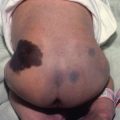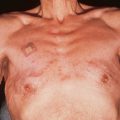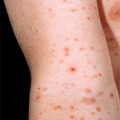Chapter 67 Approaching the pruritic patient
Bernard JD, editor: Itch: mechanisms and management of pruritus, New York, 1994, McGraw-Hill.
Fazio SB: Pruritus, UpToDate 2000, 2005. Available at: http://www.uptodate.com.
Greaves MW, Wall PD: Pathophysiology of itching, Lancet 348:938–940, 1996.
| LOCATION | DISEASES |
|---|---|
| Scalp | Psoriasis, seborrheic dermatitis |
| Trunk | Contact dermatitis (axillae, waistline), erythrasma (axillae), psoriasis (periumbilical), notalgia paresthetica, scabies, seborrheic dermatitis, urticaria |
| Inguinal region | Candida, contact dermatitis, erythrasma, overuse of topical steroids, pediculosis, scabies, tinea cruris |
| Anal region | Candida, contact dermatitis, gonorrhea, hemorrhoids, pinworm, psoriasis, tinea cruris |
| Hands | Contact dermatitis, scabies, eczema |
| Legs | Atopic dermatitis (popliteal fossae), dermatitis herpetiformis (knees), lichen simplex chronicus (malleoli), neurotic excoriations, nummular eczema, stasis dermatitis |
| Feet | Contact dermatitis, pitted keratolysis, tinea pedis |
Patient can be classified as group I, patient with pruritus on diseased inflamed skin; group II, patients with pruritus on normal noninflamed skin; and group III, patients with pruritus on chronic secondary reactive lesions such as scratching/rubbing (Table 67-2).
| CATEGORY | DISEASES |
|---|---|
Diagnostic tests for group I include a skin biopsy and laboratory investigation, such as IgE or indirect immunofluorescence. Diagnostic tests for group II include a laboratory and radiologic investigation based on the patient’s history. Diagnostic tests for group III include a skin biopsy and laboratory and radiologic investigation based on patient’s history.
Robertson KB, Meuller BA: Uremic pruritus, Am J Health Syst Pharm 53:2159–2170, 1996.
Key Points: Pruritus
Table 67-3. Treatment of Pruritus
| Topical | Cooling agents, emollients, topical corticosteroids, anesthetics |
| Systemic | Antihistamines, systemic corticosteroids, opioid receptor antagonists |
| Phototherapy | Ultraviolet B (UVB), narrowband UVB (NBUVB) |
| Miscellaneous | Transcutaneous electrical nerve stimulation (TENS), acupuncture, capsaicin |
Greece PJ, Ende J: Pruritus: a practical approach, J Gen Intern Med 7:340–349, 1992.







